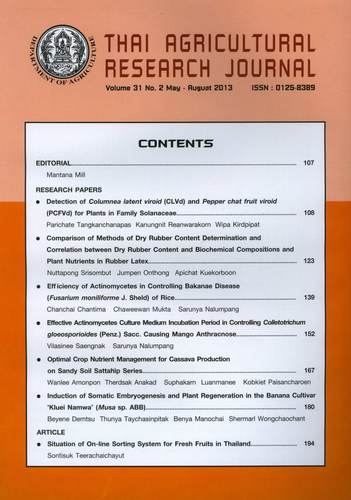Efficiency of Actinomycetes in Controlling Bakanae Disease (Fusarium moniliforme J. Sheld) of Rice
DOI:
https://doi.org/10.14456/thaidoa-agres.2013.11Keywords:
actinomyces, Bankanae disease, riceAbstract
The efficiency of actonomyces 6 isolates strain NSP1, NSP3, NSP4, NSP5, and NSP6, in controlling Fusarium moniliforme causing Bakanea disease of rice were evaluated by dual culture methods. NSP1 showed the highest inhibitory effects to mycelial growth of F.moniliforme isolated from seed and stem of rice at average percentage of 87.19%. Then, these 6 actinomycetes were cultured on enzyme production medium (EPM) by shaking at 30ºc for 5 day, and divided into two parts namely cell suspensions and culture filtrate. For testing on the inhibition of spore germinated by slide culture technique. The 5-day-old cell suspensions of each actionmycete isolate showed the inhibitory effect on the spore germination of the pathogen at percentage of 98.89, 98.61, 89.48, 74.38,76.53 and 77.57%, respectively. After that, NSP1 were tested for controlling F. moniliforme on rice seeds by inoculated the pathogen for 24 hours and then soaked into cell suspensions and culture filtrate. The results showed that non pathogen were found on NSP1-soaked rice seeds, different from control. Moreover, 15 days after inoculated pathogen and NSP1 under greenhouse conditions, the height of rice seedling in treatment of inoculated NSP1 before pathogen were 1.39-fold stage from control, 1.16- and 1.32-fold stage in treatment of inoculated pathogen before NSP1 and dual inoculated pathogen and NSP1, respectively.
Downloads
Published
How to Cite
Issue
Section
License
Copyright (c) 2017 วารสารวิชาการเกษตร (Thai Agricultural Research Journal)

This work is licensed under a Creative Commons Attribution-NonCommercial-NoDerivatives 4.0 International License.
Thai Agricultural Research Journal



